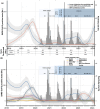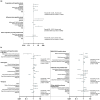Trends of respiratory viruses and factors associated with severe acute respiratory infection in patients presenting at a university hospital: a 6-year retrospective study across the COVID-19 pandemic
- PMID: 40226317
- PMCID: PMC11986719
- DOI: 10.3389/fpubh.2025.1494463
Trends of respiratory viruses and factors associated with severe acute respiratory infection in patients presenting at a university hospital: a 6-year retrospective study across the COVID-19 pandemic
Abstract
Background: The COVID-19 pandemic significantly disrupted the epidemiology of respiratory viruses, altering seasonal patterns and reducing circulation. While recovery trends have been observed, factors associated with severe acute respiratory infections (SARIs) during pre- and post-pandemic periods remain underexplored in middle-income countries.
Objective: This study aimed to analyze the trends in respiratory virus circulation and identify factors associated with SARI in patients attending a tertiary care university hospital in western Mexico over a six-year period spanning the pre-pandemic, pandemic, and post-pandemic phases.
Methods: A retrospective study was conducted using data from 19,088 symptomatic patients tested for respiratory viruses between 2018 and 2024. Viral trends were analyzed through interrupted time series (ITS) modeling, incorporating locally estimated scatterplot smoothing (LOESS) and raw positivity rates. Additionally, ITS analysis was performed to evaluate temporal changes in SARI proportions across different phases of the pandemic. Multivariate logistic regression models were applied to determine independent risk factors for SARI across different time periods.
Results: During the pandemic (2020-2021), respiratory virus positivity rates significantly declined, particularly for influenza, which experienced a sharp reduction but rebounded post-2022. Respiratory syncytial virus (RSV) demonstrated a delayed resurgence, whereas other respiratory viruses exhibited heterogeneous rebound patterns. ITS modeling of SARI proportions revealed a significant pre-pandemic increasing trend, followed by a slower rise during the pandemic, and a sharp post-pandemic drop in early 2022, before resuming an upward trajectory. Among older adults (>65 years), a marked increase in SARI was observed at the beginning of the pandemic, while younger groups showed more stable patterns. Logistic regression identified advanced age, male sex, cardiovascular disease, obesity, and immunosuppression as major risk factors for SARI, while vaccination consistently showed a protective effect across all periods and subgroups.
Conclusion: The COVID-19 pandemic induced persistent shifts in respiratory virus circulation, disrupting seasonal dynamics and modifying the burden of SARI. The findings underscore the importance of continuous surveillance, targeted vaccination programs, and early diagnostics to mitigate severe outcomes. These results highlight the need for adaptive public health strategies in middle-income countries to address evolving respiratory disease threats.
Keywords: COVID-19; epidemiology; influenza; respiratory syncytial virus (RSV); respiratory virus trends; respiratory viruses; severe acute respiratory infection (SARI).
Copyright © 2025 De Arcos-Jiménez, Martinez-Ayala, Quintero-Salgado, Lopez-Romo and Briseno-Ramirez.
Conflict of interest statement
The authors declare that the research was conducted in the absence of any commercial or financial relationships that could be construed as potential conflicts of interest.
Figures






Similar articles
-
Seasonal Shifts in Influenza, Respiratory Syncytial Virus, and Other Respiratory Viruses After the COVID-19 Pandemic: An Eight-Year Retrospective Study in Jalisco, Mexico.Viruses. 2024 Dec 8;16(12):1892. doi: 10.3390/v16121892. Viruses. 2024. PMID: 39772198 Free PMC article.
-
Detection of Respiratory Viruses Other Than SARS-CoV-2 in a Large Hospital Laboratory in Rome, Italy, During the Seasons 2016-2017 to 2022-2023.Influenza Other Respir Viruses. 2025 Feb;19(2):e70079. doi: 10.1111/irv.70079. Influenza Other Respir Viruses. 2025. PMID: 39978409 Free PMC article.
-
Hospital-based cross-sectional study on the clinical characteristics of children with severe acute respiratory infections in Hungary.BMC Infect Dis. 2024 Nov 9;24(1):1268. doi: 10.1186/s12879-024-10186-6. BMC Infect Dis. 2024. PMID: 39521980 Free PMC article.
-
Physical interventions to interrupt or reduce the spread of respiratory viruses.Cochrane Database Syst Rev. 2020 Nov 20;11(11):CD006207. doi: 10.1002/14651858.CD006207.pub5. Cochrane Database Syst Rev. 2020. Update in: Cochrane Database Syst Rev. 2023 Jan 30;1:CD006207. doi: 10.1002/14651858.CD006207.pub6. PMID: 33215698 Free PMC article. Updated.
-
Characterising the asynchronous resurgence of common respiratory viruses following the COVID-19 pandemic.Nat Commun. 2025 Feb 13;16(1):1610. doi: 10.1038/s41467-025-56776-z. Nat Commun. 2025. PMID: 39948338 Free PMC article.
References
-
- Li Y, Reeves RM, Wang X, Bassat Q, Brooks WA, Cohen C, et al. . Global patterns in monthly activity of influenza virus, respiratory syncytial virus, parainfluenza virus, and metapneumovirus: a systematic analysis. Lancet Glob Health. (2019) 7:e1031–45. doi: 10.1016/S2214-109X(19)30264-5, PMID: - DOI - PubMed
MeSH terms
LinkOut - more resources
Full Text Sources
Medical

